Preface
Organization
Contents
Secret Sharing
Efficient Threshold Secret Sharing Schemes Secure Against Rushing Cheaters
1 Introduction
1.1 State of the Art and Our Results
2 Preliminaries
2.1 Secret Sharing Schemes
2.2 Cheating Detectable Secret Sharing Against Rushing Cheaters
2.3 Cheater Identifiable Secret Sharing Against Rushing Cheaters
2.4 Building Blocks of Proposed Schemes
3 A Scheme Capable of Detecting (k-1)/3 Rushing Cheaters
4 A Scheme Capable of Detecting n-1 Rushing Cheaters
5 A Scheme Capable of Identifying (k-1)/3 Rushing Cheaters
6 A Scheme Capable of Identifying (k-1)/2 Rushing Cheaters
7 Concluding Remarks
References
Dynamic and Verifiable Hierarchical Secret Sharing
1 Introduction
1.1 Motivation and Contribution
1.2 Related Work
2 Preliminaries
3 Dynamic Secret Sharing
4 Secret Sharing Based on Birkhoff Interpolation
5 Providing a Dynamic and Verifiable Hierarchical Secret Sharing Scheme
5.1 Distributed Computation of Determinants
5.2 Verifiable Algorithms for Dynamic Hierarchical Secret Sharing
5.3 Security and Efficiency
6 Conclusion and Future Work
A Requirements for Birkhoff Interpolation Matrices Interpolation
B Security Analysis
C Example of Tassa's Hierarchical Secret Sharing
References
Quantum Cryptography
Computational Security of Quantum Encryption
1 Introduction
1.1 Summary of Contributions and Techniques
1.2 Related Work
2 Preliminaries
2.1 Classical States, Maps, and the One-Time Pad
2.2 Quantum States, Maps, and the One-Time Pad
2.3 Efficient Classical and Quantum Computations
2.4 Oracles
3 Quantum Encryption and Indistinguishability
3.1 Quantum Encryption Schemes
3.2 Indistinguishability of Encryptions
4 Quantum Semantic Security
4.1 Difficulties in the Quantum Setting
4.2 Definition of Semantic Security
4.3 Semantic Security Is Equivalent to Indistinguishability
5 Quantum Encryption Schemes
5.1 Quantum Symmetric-Key Encryption from One-Way Functions
5.2 Quantum Public-Key Encryption from Trapdoor Permutations
6 Conclusion
6.1 Extensions and Future Work
References
Efficient Simulation for Quantum Message Authentication
1 Introduction
2 Preliminaries
2.1 Basic Notation
2.2 Pauli Matrices
2.3 Clifford Group
3 Quantum Message Authentication
4 Quantum Message Authentication Schemes
4.1 The Clifford Code
4.2 The Trap Code
5 Security of Quantum Message Authentication Schemes
5.1 Security of the Clifford Code
5.2 Security of the Trap Code
A Appendix
References
Visual Cryptography
Private Visual Share-Homomorphic Computation and Randomness Reduction in Visual Cryptography
1 Introduction
2 Visual Cryptography
3 Privately Computable Functions
4 Secret Sharing Homomorphism
5 Visual Homomorphic Functions
5.1 Functions X, , y, , 0, 1
5.2 Function Xor
5.3 Function Xor
6 On Randomness Saving: Strategies and Impossibility Results
6.1 Security Definition
6.2 Impossibility Results
7 Randomness Reduction
8 Conclusions and Open Problems
References
Revisiting the False Acceptance Rate Attack on Biometric Visual Cryptographic Schemes
1 Introduction
2 Framework
3 Revisiting the False Acceptance Attack
4 A New Strategy for Attacking E-BVC
4.1 A Case Analysis for RO-e-BVC
5 Conclusion
References
Cryptographic Protocols
Detecting Algebraic Manipulation in Leaky Storage Systems
1 Introduction
2 Preliminaries
3 AMD Codes for Leaky Storage
3.1 Definition of -AMD
3.2 Efficiency Bounds for -AMD Codes
4 Limited-View -AMD Codes
5 Applications
5.1 Robust Ramp SSS
5.2 Wiretap II with Algebraic Adversary
6 Conclusion
A Proof of Lemma 4
B Proof of Lemma 5
C Proof of Proposition 2
D Proof of Construction 4
References
Cheater Detection in SPDZ Multiparty Computation
1 Introduction
2 The Original SPDZ Protocol
2.1 The Setting
2.2 Ingredients
2.3 Outline of the SPDZ Protocol
3 Our Protocol
3.1 An Overview of Our Protocol
3.2 The Checking Protocol BlockCheck
3.3 Security of Our Protocol
3.4 The Complexity of Our Protocol
4 Conclusion
A The Protocol BlockCheck in Detail
A.1 The Tag Checking in Detail
A.2 The Complexity of the Block Check
B The Commitment Check
C Checking the Input and Output of the Computation
References
Error-Correcting Codes Against Chosen-Codeword Attacks
1 Introduction
1.1 Ideas of the Construction
1.2 Related Work
2 Preliminaries
2.1 Notations
2.2 Error-Correcting Codes
3 Formal Model
4 Our Construction
4.1 Overview
4.2 Ingredients
4.3 The Construction
5 Security Proof
References
Efficient Generic Zero-Knowledge Proofs from Commitments (Extended Abstract)
1 Introduction
1.1 Contribution
2 Definitions and Notation
2.1 Universal Composability
2.2 Notation
3 Commitments with Linear Proofs
4 Zero-Knowledge with Soundness-Error One-Half
4.1 Protocol for Equality
4.2 Parallel Equality Proofs and Proofs of Inequality
4.3 Linear Zero-Knowledge Proof
5 And-Proof with Soundness-Error Three-Quarter
6 Honest-Verifier Zero-Knowledge Proof for Circuit Satisfiability
6.1 Generating the Set S
7 Implementation
8 Conclusion
A Universal Composability Framework
A.1 Ideal Functionalities
B Inequality Protocol
C Parallel Equality Proofs
D Parallel Linear Proof
E Simulation of Mult
F Reproducing Our Empirical Studies
References
Unconditionally Secure Revocable Storage: Tight Bounds, Optimal Construction, and Robustness
1 Introduction
1.1 Background
1.2 Our Contributions
1.3 Related Work
2 Revocable-Storage Broadcast Encryption
2.1 Model
2.2 Security Definition
3 Tight Lower Bounds on Sizes of Ciphertexts and Secret Keys
4 Construction
5 Robust Construction
A Shannon Entropy
B Collusion-Resistant RS-BE Scheme
C Construction for Arbitrary Plaintext Sizes and Number of Users
References
Entropy, Extractors and Privacy
A Practical Fuzzy Extractor for Continuous Features
1 Introduction
1.1 Information Reconciliation for Discrete Data
1.2 Fuzzy Extractors for Discrete Data
1.3 Information Reconciliation for Continuous Data
1.4 Related Work: Fuzzy Extractors for Continuous Data
1.5 Contributions of This Paper
2 Preliminaries
2.1 Lattice
2.2 Lattice Codes and the Unconstrained Power Channel
2.3 Discrete and Continuous Fuzzy Extractors
3 A CS-Fuzzy Extractor Assuming White Gaussian Noise
4 Dealing with Different Types of Noise
4.1 Gaussian Approximation Using the Central Limit Theorem
4.2 Variance Normalization to Stay Within the Correction Capacity
5 Proof of Security of Our Fuzzy Extractor
6 Practical Construction with Low-Density Lattice Codes
7 Conclusion
8 Open Questions and Possible Future Work
A Proof of Theorem1
B Proof of Theorem2
References
Almost Perfect Privacy for Additive Gaussian Privacy Filters
1 Introduction
1.1 Contributions
1.2 Preliminaries
2 Rate-Privacy Function for Additive Privacy Filters
3 Estimation-Theoretic Formulation
4 Conclusion
A Connection Between Mutual Information and Non-Gaussianness
B Completion of the Proof of Theorem4
References
A Better Chain Rule for HILL Pseudoentropy - Beyond Bounded Leakage
1 Introduction
1.1 Entropy Notions and Chain Rules
1.2 Motivation: Limitations of Pseudoentropy Chain Rules
1.3 Our Results
1.4 Our Techniques
1.5 Paper Organization
2 Preliminaries
2.1 Basic Definitions
2.2 Pseudoentropy
3 Auxiliary Facts
4 Results
4.1 Flexible Chain Rule for Conditional Pseudoentropy
4.2 A Conditional Chain Rule for Noisy Leakage
5 Applications
5.1 Known Chain Rules for Unconditional Pseudoentropy
5.2 Stream Ciphers Resilient Against Noisy Leakages
5.3 Better Handling (some) Noisy Leakages
5.4 Noisy Leakage Basics
6 Open Problems
A Proof of Corollary2
B Proof of Theorem 3
C Proof of Theorem 4
References
Author Index
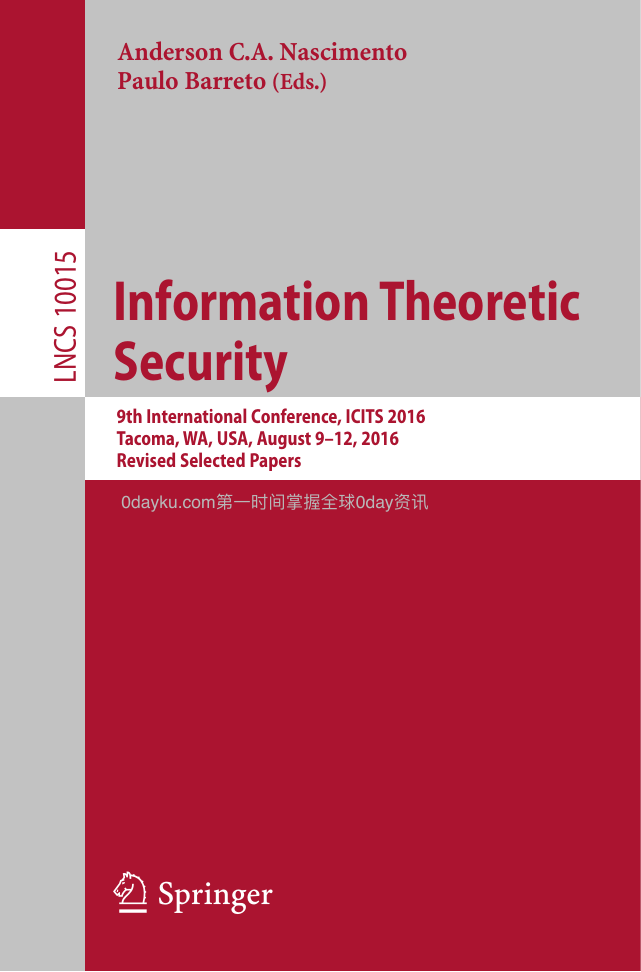
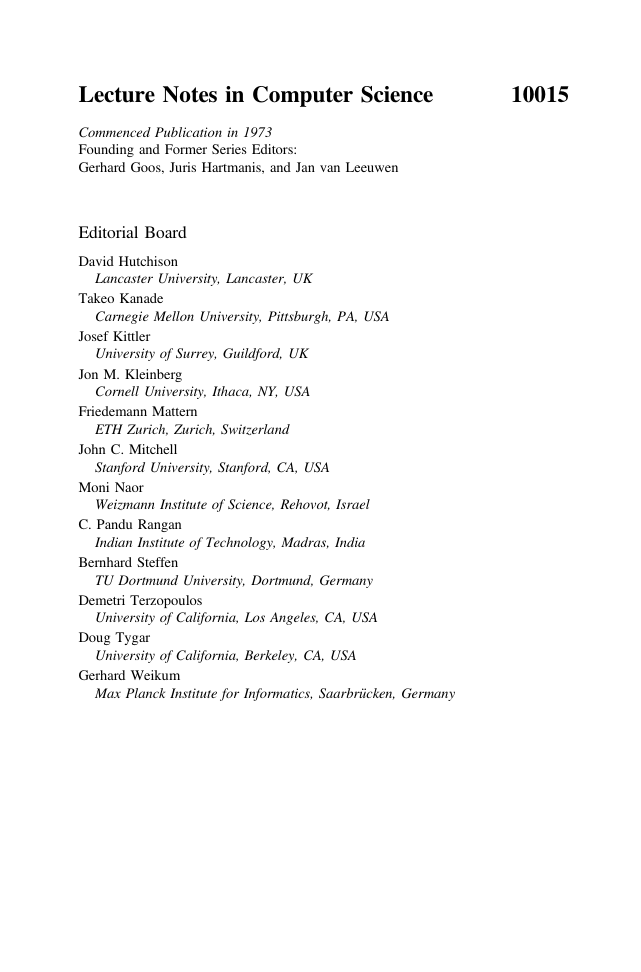

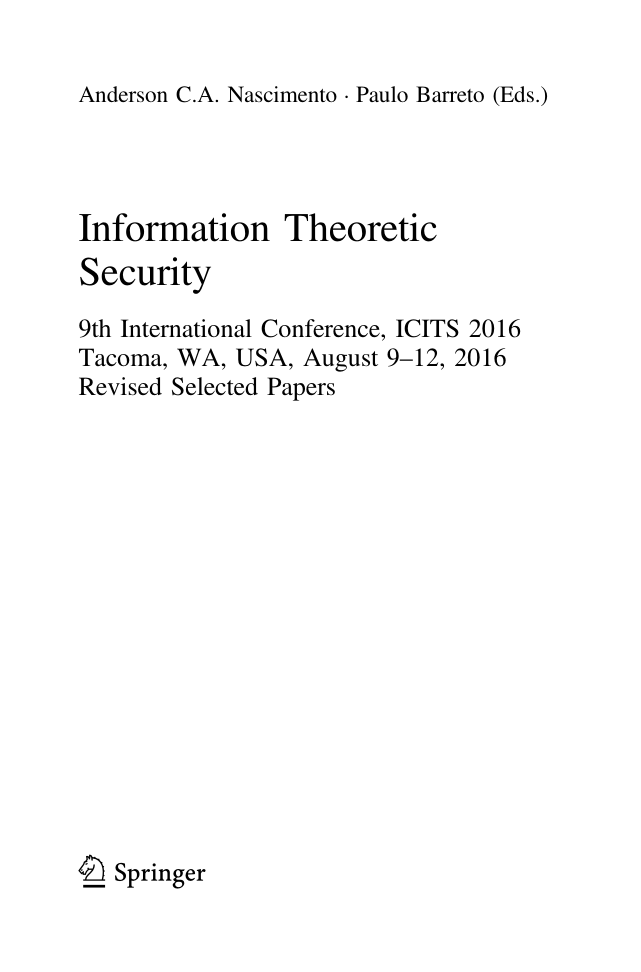
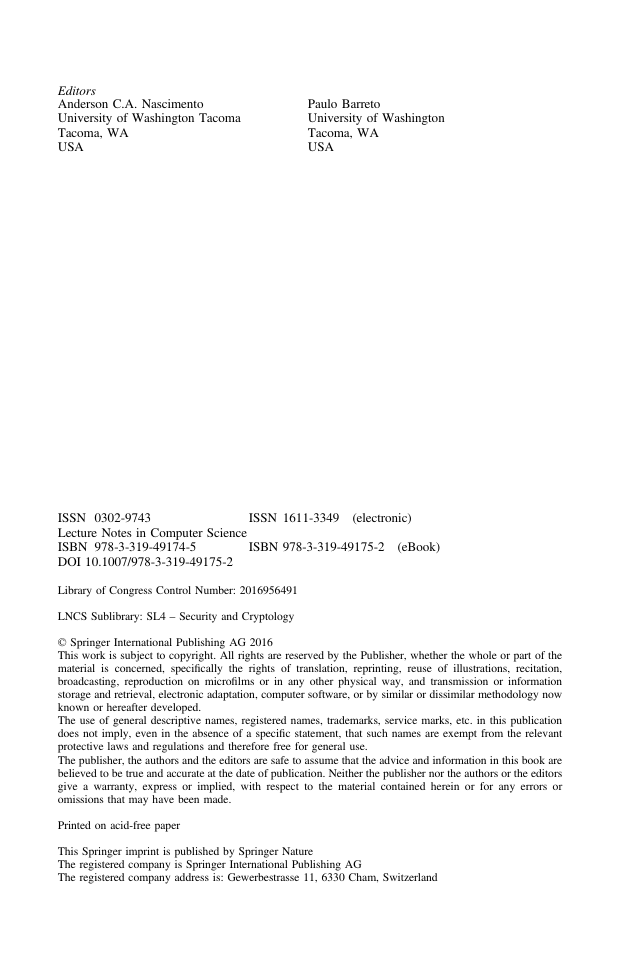
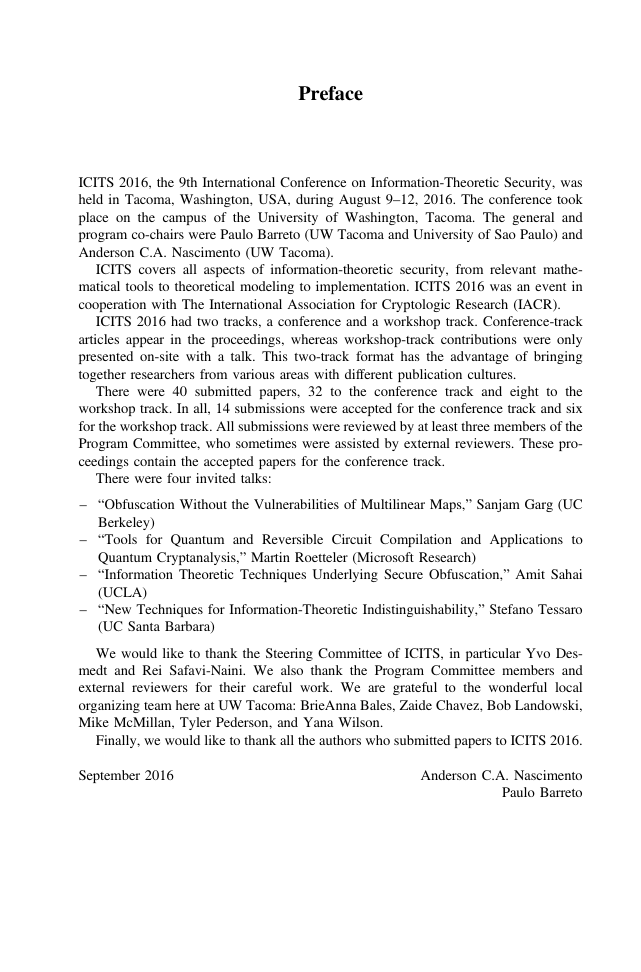
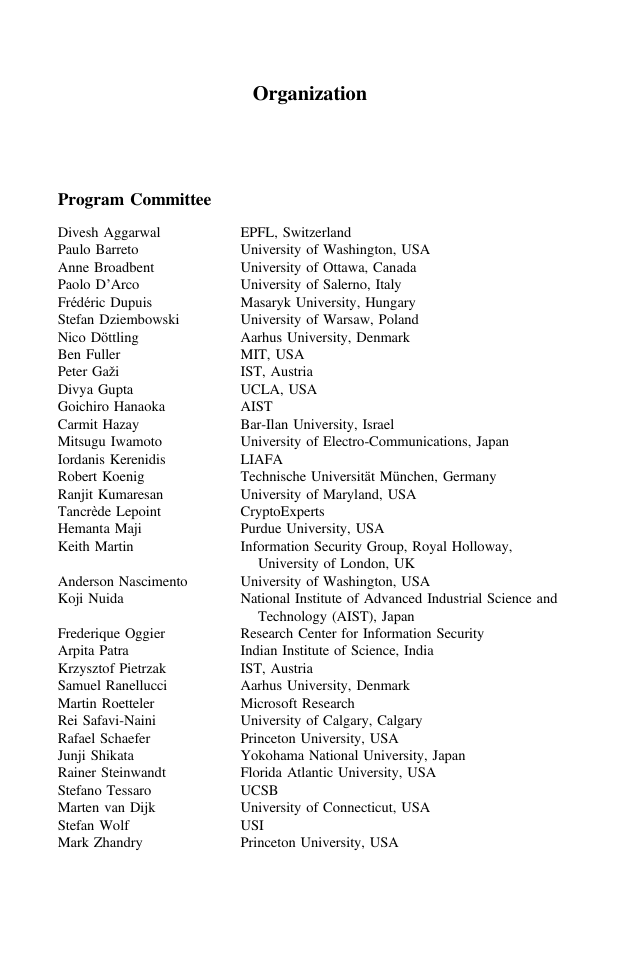
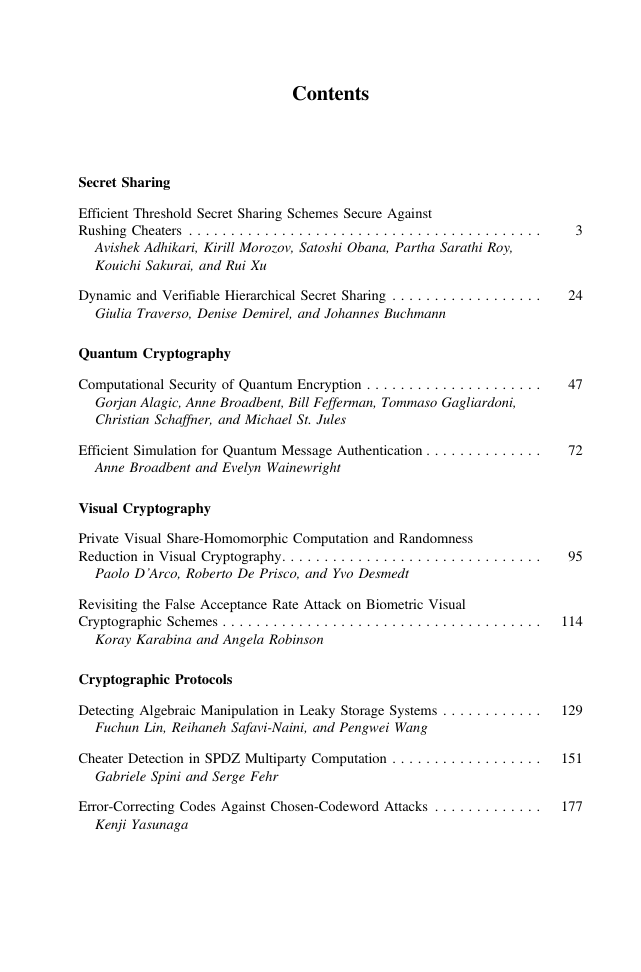








 2023年江西萍乡中考道德与法治真题及答案.doc
2023年江西萍乡中考道德与法治真题及答案.doc 2012年重庆南川中考生物真题及答案.doc
2012年重庆南川中考生物真题及答案.doc 2013年江西师范大学地理学综合及文艺理论基础考研真题.doc
2013年江西师范大学地理学综合及文艺理论基础考研真题.doc 2020年四川甘孜小升初语文真题及答案I卷.doc
2020年四川甘孜小升初语文真题及答案I卷.doc 2020年注册岩土工程师专业基础考试真题及答案.doc
2020年注册岩土工程师专业基础考试真题及答案.doc 2023-2024学年福建省厦门市九年级上学期数学月考试题及答案.doc
2023-2024学年福建省厦门市九年级上学期数学月考试题及答案.doc 2021-2022学年辽宁省沈阳市大东区九年级上学期语文期末试题及答案.doc
2021-2022学年辽宁省沈阳市大东区九年级上学期语文期末试题及答案.doc 2022-2023学年北京东城区初三第一学期物理期末试卷及答案.doc
2022-2023学年北京东城区初三第一学期物理期末试卷及答案.doc 2018上半年江西教师资格初中地理学科知识与教学能力真题及答案.doc
2018上半年江西教师资格初中地理学科知识与教学能力真题及答案.doc 2012年河北国家公务员申论考试真题及答案-省级.doc
2012年河北国家公务员申论考试真题及答案-省级.doc 2020-2021学年江苏省扬州市江都区邵樊片九年级上学期数学第一次质量检测试题及答案.doc
2020-2021学年江苏省扬州市江都区邵樊片九年级上学期数学第一次质量检测试题及答案.doc 2022下半年黑龙江教师资格证中学综合素质真题及答案.doc
2022下半年黑龙江教师资格证中学综合素质真题及答案.doc